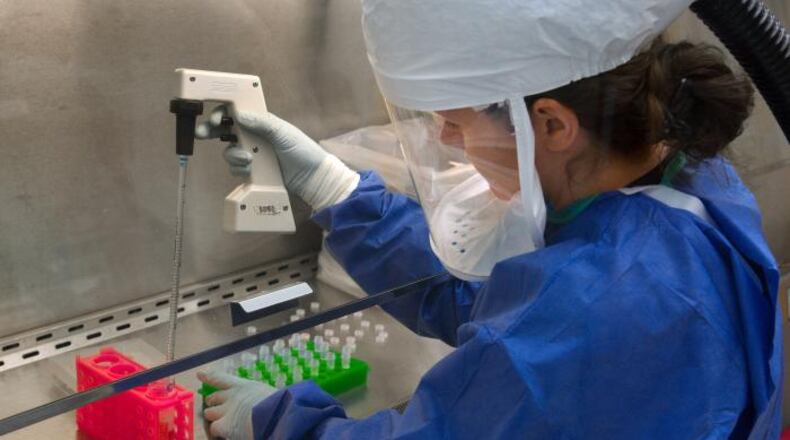Dr. William Bower’s job is to investigate some of the world’s most lethal bacteria, ones that, unchecked, can cause mass casualties or be weaponized for bioterrorism.
His team at the Centers for Disease Control and Prevention has worked on cases involving diseases like anthrax, which killed five people in the 2001 bioterror attacks; brucellosis, where outbreaks have caused spontaneous miscarriages and endocarditis; and leptospirosis, which can trigger kidney or liver failure, bleeding from the lungs.
But the disease that had his team concerned this year was one most U.S. doctors may never see: melioidosis. The bacteria that cause it are most commonly found in soil and water in Southeast Asia and northern Australia. So how, CDC scientists scrambled to find out, had it killed a Kansas woman who hadn’t traveled? Was it the first sign of a larger threat to the American public?
The CDC’s work to solve the mystery may have spared thousands from the disease, which also killed a young Georgia child this past summer. Identifying and disarming such biological threats is the mission of the branch of the CDC for which Bower works: the Division of High Consequence Pathogens and Pathology. When public health officials across the U.S. or around the globe need help with dangerous germs that fall under its broad umbrella of expertise, the division’s scientists are at their call.
What startled the CDC after the Kansas death was a report two months later about another melioidosis case, one involving a severely ill Texas patient who also had no travel history. Worried that there may be more cases not recognized by physicians, CDC notified medical providers to test for the bacteria that causes the disease, Burkholderia pseudomallei, in patients with severe pneumonia.
“This is something that could be distributed across the whole United States,” Bower said he feared.
Then CDC was alerted to another case, involving a severely ill patient in Minnesota.
Credit: Centers for D
Credit: Centers for D
Epidemiologists and laboratory scientists worked 12 to 14 hours a day, seven days a week, concerned that a product, likely from Asia, had sickened all three patients. If so, others could be at risk. Virtually everything in the patients’ houses was suspect. Epidemiologists and laboratory scientists worked to gather hundreds of samples, searching for clues.
Back at the CDC Level 3 biocontainment lab, workers collaborated to test samples for the bacteria — a process made more complex because the bacteria could be present in low numbers and mixed in with other product components. This can make it difficult to determine the presence of the bacteria. So the samples had to be put in an “enrichment broth” that helps the bacteria to grow.
The work turned up nothing.
“We had resolved ourselves that we may not find it,” said microbiologist Mindy Glass Elrod. “That is a hard thing to stare down.”
The Georgia child’s death in late July finally broke the case.
In August, Elrod, CDC epidemic intelligence officer Julia Petras and two Georgia public health workers met with the grieving family, asking that they try to identify everything that the child may have been exposed to, that his skin may have come in contact with, that he might have breathed in or might have eaten.
The team dug up soil and put it in biohazard bags, but focused on products that were wet, knowing this particular organism likes water. “Oils, lotions, sprays, food,” Bower said.
Back at the lab, the team put the latest samples in the growth media, so they could do tests to detect the bacteria. It was a week-long process for each sample.
Again, testing turned up nothing. In October, Elrod had to go back to the distraught family, this time with laboratory scientist Zachary Weiner.
“We said, ‘Let’s go through this again and see if there is anything else they had been exposed to and we could test,’ " Bower said.
Finally, the lab had a hit. A $4 bottle of aromatherapy room spray, Better Homes & Gardens Lavender & Chamomile Essential Oil Infused Aromatherapy Room Spray with Gemstone, manufactured in India and sold by Walmart, was contaminated with the bacteria.
The team quickly notified the Consumer Product Safety Commission (CPSC) and Walmart, which immediately pulled the product from its shelves and recalled 3,900 bottles of the spray in six different scents.
A final step to solve the mystery: CDC lab scientists had to find out if the DNA fingerprint of the bacteria in the spray matched the strains that infected the four people.
It did. The CDC had found the needle in a haystack.
Postscript: The Centers for Disease Control and Prevention is now working with the CDC country office in India to learn more about how the aromatherapy spray that caused the melioidosis outbreak became contaminated, while an agency of the government of India is taking the lead on investigating the manufacturer. Testing of five other scents of the product is ongoing, the CDC said, but no additional melioidosis cases or serious illnesses linked to the product have been reported.
Walmart has not released information on how many of the recalled bottles have been returned. Anyone who has the 5-ounce glass bottle, sold with a pump spray nozzle and labeled “Better Homes and Gardens Aromatherapy,” should stop using it immediately. It should not be thrown in the trash. Instead, the bottle should be placed in a zip-top resealable bag and placed in a cardboard box. Then it should be returned to a Walmart store for a refund.
About the Author
Keep Reading
The Latest
Featured



